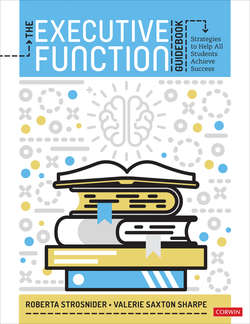Читать книгу The Executive Function Guidebook - Roberta Strosnider - Страница 26
На сайте Литреса книга снята с продажи.
Step 3 Considering UDL and metacognition, select an EF skill-building strategy and get commitment from the student. Add the strategy to the Game Plan.
ОглавлениеTo optimize the learning of all students, least of all students with executive function deficits, it is imperative to incorporate the three principles of Universal Design for Learning (UDL) into lessons: Multiple Means of Representation, Multiple Means of Action and Expression, and Multiple Means of Engagement. As a teacher, it is imperative that lessons are flexible, adaptable, and customizable, making them accessible to all learners. Following the guidelines of UDL will help ensure your lessons incorporate techniques and tools that provide options and scaffolds for executive functions.
Incorporating the metacognitive process, consider your student’s learning needs, including EF deficits and strengths, to select the manner of teaching best suited to the student. Also consider the executive function and other needs of all students in the class. Decide how you will account for the student’s particular executive function deficits and learning needs in the lesson, as well as in pre-, formative, and summative assessments. Select approaches, material customizations, supports, options, modifications or adaptations, and tools, including assistive technology, to include in instruction. Some supports will benefit all learners or multiple learners, while others will be applicable to only the student in question. At the same time, start thinking about EF skill-building strategies you can teach the student while modeling metacognition throughout the process.
Once you have determined the executive function skill and skills that are most important for the lesson, how the student’s EF deficit will impact his or her learning, and how to design the lesson using UDL principles, consider which EF skill-building strategies to teach the student to help address the deficit. Each chapter includes several different strategies that can be used to address the EF function area addressed in that chapter.
Table 1.6 provides a structure for planning, integrating UDL and metacognition, and choosing an appropriate strategy for use with the student. The components in this table should be thought about prior to teaching the student the strategy. Table 1.6 is to be used to guide your thinking about the components involved when selecting a strategy for the student. A blank template for this chart is provided in the Appendix 1.10, and blank templates, modifiable versions of materials, and strategy cards can be found at http://resources.corwin.com/ExecutiveFunctioning.This process is flexible as to both your needs and the needs of your student. After a strategy is selected, add it to the student’s game plan.
Questions for the student to answer are listed on table 1.7. Using these tables will lead you through a process that results in appropriate strategy selection.
TABLE 1.6
Once you and the student have selected a strategy, add the strategy name to the “Things I can do to help with my difficulties in school” column of the Game Plan for an elementary student (figure 1.9) or the “Action” column of the Game Plan for a secondary student (figure 1.10). Technology that supports the strategy such as websites, software, and apps should be added to these columns of the Game Plan as well.
The final phase of step 3 addresses the student’s responsibility. It is important that the student take an active role in the strategy learning process. Once the strategy is selected, the student completes table 1.7 Student Implementation of Strategy With a Focus on Metacognition and UDL Principles. This helps the student to use the metacognitive process when responding to the questions posed, as well as taking ownership of his or her role in learning the strategy. A blank template for this chart is available in Appendix 1.11, and blank templates, modifiable versions of materials, and strategy cards can be found at http://resources.corwin.com/ExecutiveFunctioning.
TABLE 1.7 Student Implementation of Strategy With a Focus on Metacognition and UDL Principles
